Hierophany. A manifestation of the divine, the sacred, that which escapes language.
Last week, I wrote of story and gameplay: “In playing, we aren’t so much narrating these events or enlivening story fragments as sequential processes; we’re engaging in something like the mythic, touching some essence of what’s happening in a represented event.”
Engaging in something like the mythic. Touching some essence of what’s happening in a represented event. There was something else, something just out of reach, a crackling pulse at the other end of my fingertips that I didn’t say, and perhaps couldn’t have said.
And then, when I was at my LGS’s Commander Night, I happened to look down at the card I was playing.
“She reaches beyond the physical realm, touching the ideals from which all creatures draw their power.”
Auras, I think, are the forgotten card type among Magic flavorheads. It’s understandable: why talk about an Enchantment subtype when you could discuss the Creatures that inhabit Magic’s world, the Sagas they use to tell their own stories, the Artifacts they tote around, the Instants and Sorceries representing the spells they fling across the battlefield, or the Planeswalkers whom they revere as gods? It doesn’t help, of course, that Auras are mechanically tricky. Auras, especially Auras that buff creatures, often have a hard time finding a home: when a creature dies, the Aura goes with it, making them almost categorically worse in value than the other buff-em-up option, Equipment (Wilds of Eldraine, the set whose GW precon was the genesis of my Commander Night deck, attempted to mitigate this issue with Roles, to mixed success).
Then, there’s the flavor issue. Creatures and artifacts are easy; they represent individuals and the tools they use. But what is an Aura?
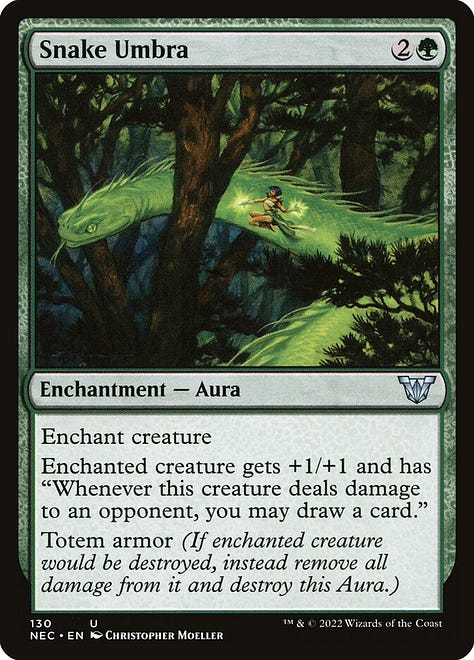

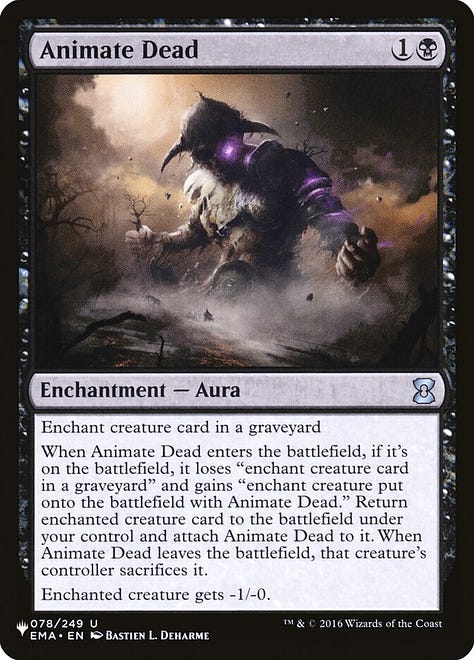
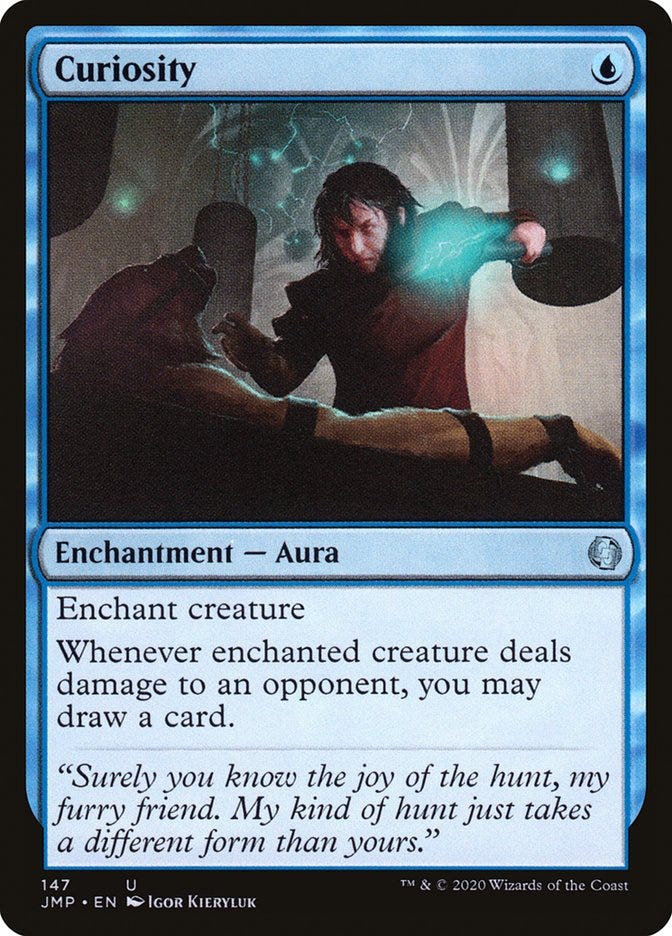
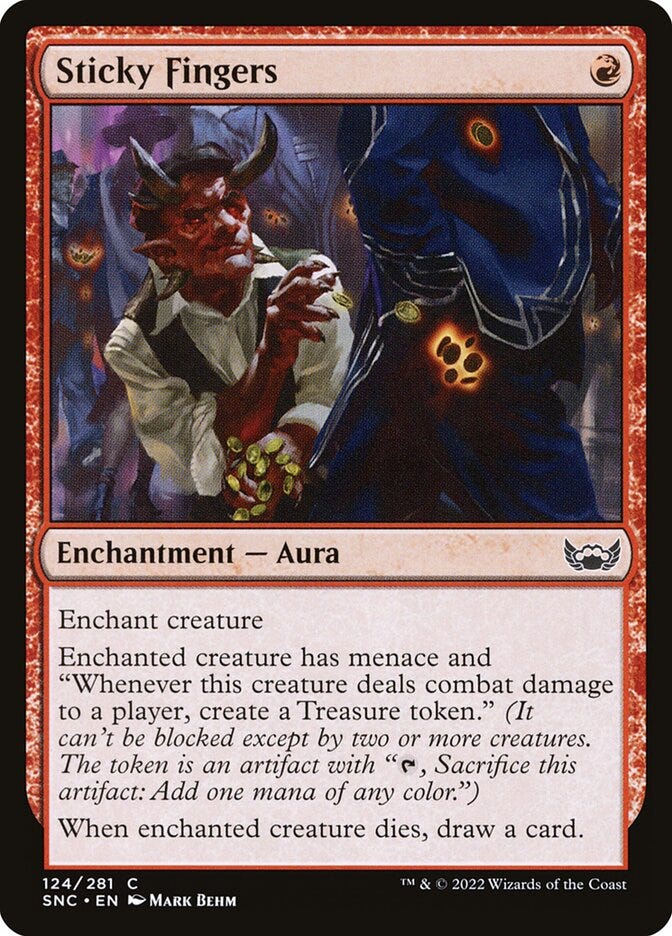
Snake Umbra and its fellow umbrae, evoking a kind of shamanistic spiritualism,1 picture spiritual animals that encase their wielders control; Ethereal Armor is a suit of hardlight steel; Animate Dead is a necromantic curse; Sticky Fingers is some sort of telekinetic ability; Curiosity is simply an emotion. What’s the commonality?
When I read the flavor text on Kor Spiritdancer, things clicked into place.
What’s an ideal?
The word comes from the Latin idealis, which refers to “having the nature of an Idea,” which itself is rooted in “an abstract or eternally existing pattern or archetype of any kind of thing, in relation to which particular things are conceived as imperfect copies or approximations.” An ideal, in this sense, is a general or universal category to which a particular entity might belong.
The term’s deeper conceptual roots belong to Plato, who elaborated the famous notion of Forms: the idea that the world we perceive is the mere hazy shadow of a higher world, in which the essence of each thing exists in its pure form. In some interpretations of Platonic metaphysics, each individual thing has its own Form; in other interpretations (especially Neoplatonism, as developed by Plotinus and others) each individual thing is merely part of a cascading train of self-expression that traces back to a transcendental singularity, an absolute Oneness. The notion of a realm of ideals has seeped deep into culture and philosophy; noteworthy philosophical idealists include German Romantics (like Goethe, Schelling, and Hegel) who, each with their own eclectic paradigms, believed that the world we perceive is at least in part a mediation of a transcendental world of ideas not immediately legible to us. These ideas, esoteric as they seem, have plenty of purchase in high fantasy. Think, for instance, of the way the Dungeons & Dragons cosmologies imagine realms that embody pure moral ideals, or of the Spiritual Realm in Brandon Sanderson’s Cosmere, where things exist in their most perfect state.
An ideal. An archetype. A Form. The most perfect version of a thing that exists beyond our mortal existence, that which undergirds the worldly manifestations of things we see. This is what Kor Spiritdancer wields: she grasps for the realm of pure ideality just beyond the physical world, touching the most perfect spiritual essences of things.
In this realm, she finds what makes a snake a snake, then weaves the fabric of magical energy, enshrouding herself with the essence of snakeness. She grasps the essence of armor, clothing herself in a protection that needs no physical form. She finds the essence of animacy and imparts it even upon the dead. She uncovers the essence of thievery and rivets it to her own hands. She runs her finger through curiosity itself and infuses it into her body. She touches the essence of hatred and gives it form—and some of the best flavor text in Magic’s history.
Platonic idealism has its challenges. Realists might dismiss it as hokum; sensualists and Epicureans might caution that it denies the virtue of the material world; subjective idealists might argue that though the world is conceptual, it isn’t governed by any archetypical ideals. But one of the strongest beefs comes from within Platonism/Neoplatonism itself: if the ideal world is so radically different from our own, how is it possible to access it?
For that matter, if Auras represents the ideal essences of things in their magically condensed form, what does it mean to play an ideal essence as a game piece? What I mean is: is the ideal embodiment of all hatred reducible to gaining 2 power and trample?
For Plato himself and for the Neo-Platonist big boss Plotinus, the answer is careful contemplation on the imperfect ways that the Forms appear to us in the world. The Early and Medieval Christian thinkers that adopted Neo-Platonism, though, went further. For such theologians, it was of utmost importance to clarify that humans fail to know God because God is so radically different from the created world, even in our nearest similarity. As the mystic theologian Pseudo-Dionysius the Aeropagite puts it: “For God abides above created intellect and existence, and is in such sense unknowable and non-existent that He exists above all existence and is known above all power of knowledge. Thus the knowledge of Him who is above all that can be known is for the most part ignorance.”
But that wasn’t the end of the story, for Pseudo-Dionysius. Although God—the supreme ideality—is beyond our human conceptions, we can begin to approach God through symbol. This isn’t the kind of symbol like the Apple logo or the picture on a restroom sign—rather, it’s a special kind of symbol, a hierophany that discloses the ineffable to our experience even though it’s fragmentary in nature. For Pseudo-Dionysius, the soul lives in a world of sensuous things, and so to grasp the ineffable, it has to grasp onto sensible things as perceptible signs that elevate us beyond them—“inspired symbols” that might “lead us through the sensible to the intelligible…to the simple sublimities of the Heavenly Hierarchy.”
Over a millennium later, Johann Wolfgang von Goethe, drawing on a long tradition of thought including that of Pseudo-Dionysius, would write that the capital-s Symbol is “the momentary living revelation of the ungraspable.” Thomas Carlyle, himself inspired by Goethe, suggests that “In the Symbol proper, what we can call a Symbol, there is ever, more or less distinctly and directly, some embodiment and revelation of the Infinite; the Infinite is made to blend itself with the Finite, to stand visible, and as it were, attainable there.” Such symbols fling us beyond themselves, invoking an essence of ideality and elevating us into it.
Previously, I wrote that “[i]n playing, we aren’t so much narrating these events or enlivening story fragments as sequential processes; we’re engaging in something like the mythic, touching some essence of what’s happening in a represented event.” Such is the nature of a card game with mythic stakes: it’s not as though we can summon the essence of Ethereal Armor before us, so we use a game piece to represent the ideal we’re evoking, the mythic power that we’re recollecting.
When I play an Aura, I’m drawing on, and perhaps recreating a symbol—limited, contingent, fragmentary, and yet somehow containing the propulsive power to elevate me beyond itself—to the ideal. Although gaining 2 power and trample can’t begin to capture the absolute nature of hatred itself, the card’s art and its narrative and its game mechanics all condense a whole network of meanings into a symbolic experience of this ideal, this hatred, that might even propel us beyond the tangle form of the card and into the thing it points to.
The same is true for any other card. When I play Negate, the mere act of countering a noncreature spell could never directly represent the enormity of Ajani’s curing at the end of March of the Machine—but by evoking that moment through art, by infusing it into game mechanics, by entering it into the sensible realm of my experience, there emerges an opportunity to feel all that that moment represented and meant. If there is something that makes Magic special, it’s that maybe, just maybe, the art and flavor and mechanics all converge networks of meaning that propel us toward something ineffable, something that escapes language but that has lowered itself ever-so-momentarily into perceptible form.
Kor Spiritdancer’s curse is our curse, and her power is our power. She can grasp the realm of ideals—feel them, experience them—but to bring them to our sensible world, she must clothe them in sensible form. So too must we. We touch ideals, using their power to navigate a reality suffused with meaning, but we can only do so through physical, limited, symbolic forms: shimmering armor and mechanical “protection” points us toward whatever absoluteness it is to which the word “protection” refers; glowing faunal shapes and enhanced abilities point toward the essence of biological life; a returned permanent and a decaying body point toward the essence of animacy; the moment of earning and a card-draw opportunity point toward totalizing curiosity; crackling power and enhanced strength and the impetus to combat point toward Rancor itself.
Whether these idealities are true to our perceptions of them (whether, in other words, there really is an ideal Rancor and ideal Curiosity and ideal Animacy and ideal Snakehood), or whether these are the names we wrap around the sublime and ineffable power that exceeds our minds and vitalizes our existence—that’s a matter of personal philosophy, and this isn’t the time or place I could convince you about it.
But what I hope to have convinced you of, reader, is that in playing Magic, you, like Kor Spiritdancer, have become a hierophant.
Nota bene: Wizards of the Coast has made the (in my view, correct) choice to shift the keyword text of the umbrae from “Totem armor” to “Umbra armor.”

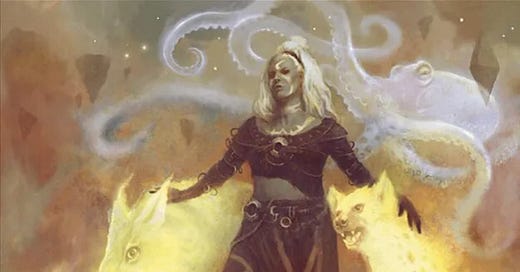


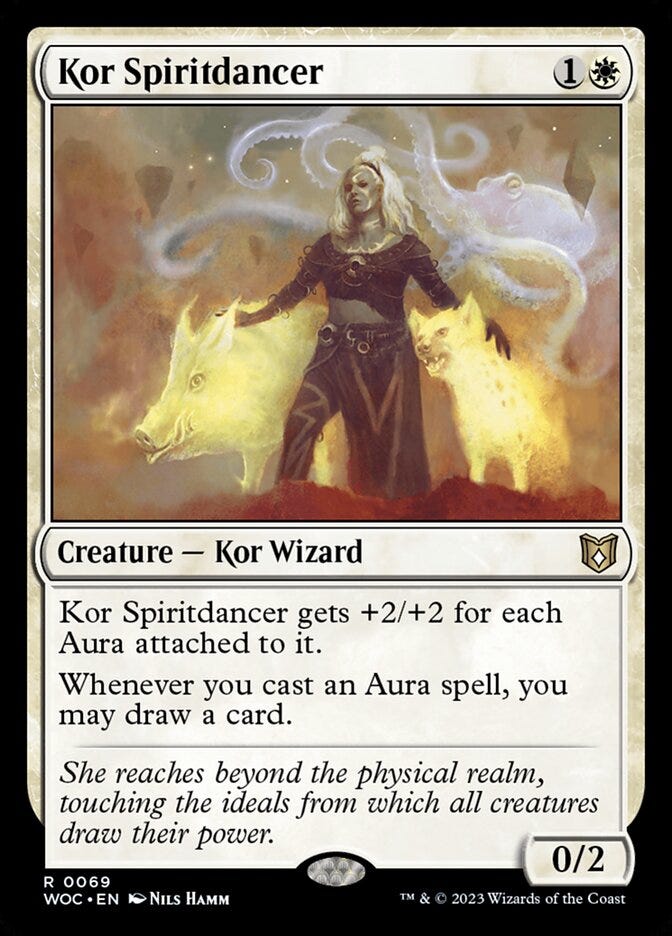
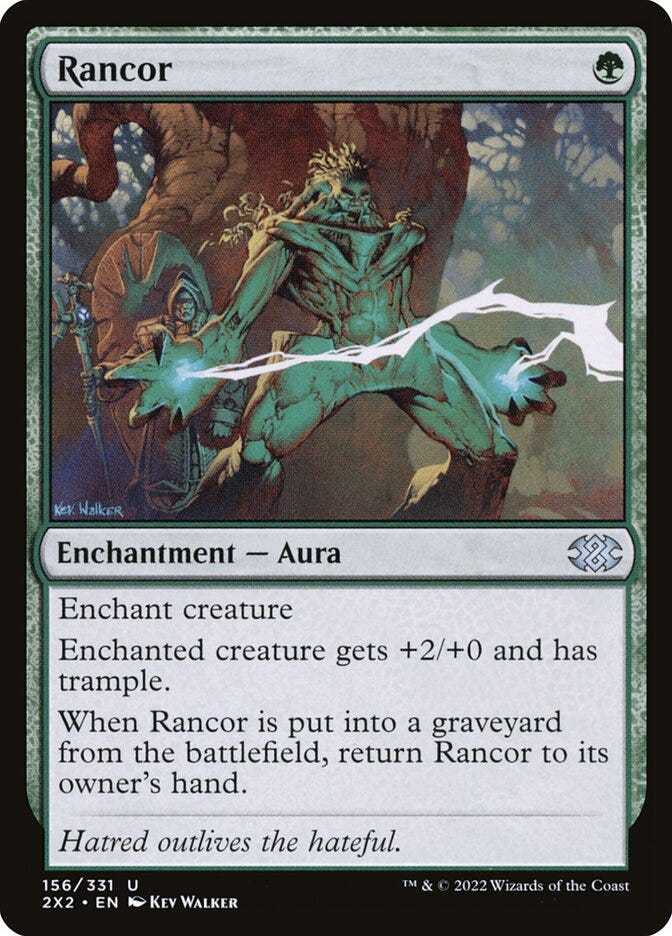
While I fully support changing the name of the ability, I still think they should have gone with "Umbral Armor" instead of just "Umbra Armor".
Also, this made me think of the magic system from Robert Jordan’s Wheel of Time series - where users draw upon the One Source, an eternal pool of the energy of creation, and Channel that energy into their task. It’s a more literal take on touching an ideal realm and causing it to manifest in our physical realm, and I think you might find it interesting: https://wot.fandom.com/wiki/One_Power